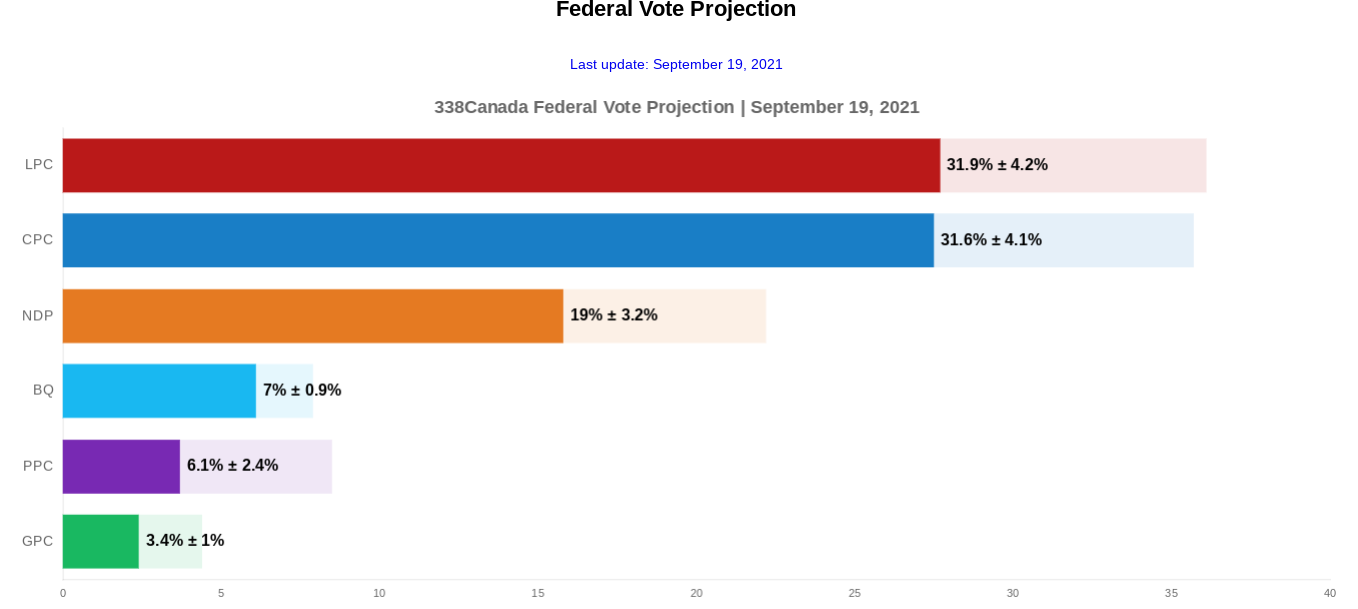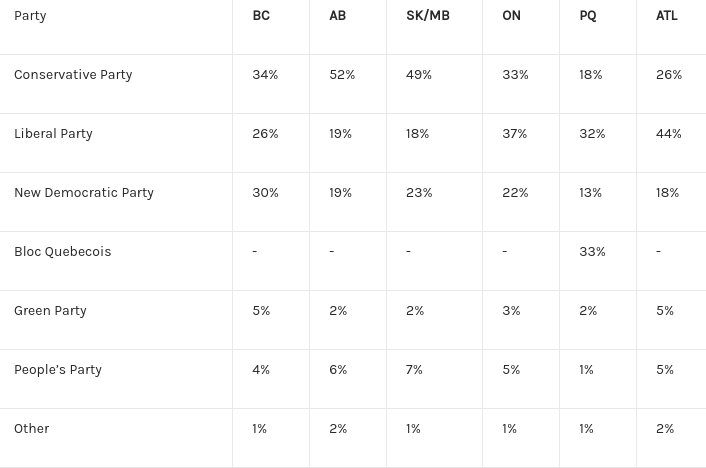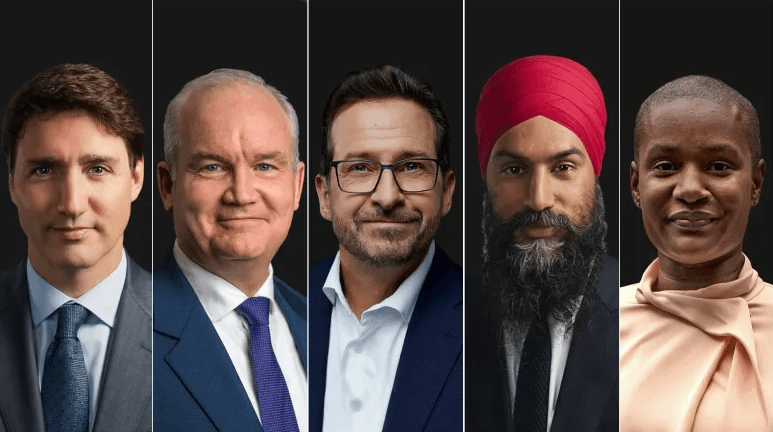The candidates for Canada’s 2021 Federal Election made their final appeals to voters on the last day of campaigning on Sunday as voting ends on Monday night.
The candidates are incumbent Prime Minister (PM) Justin Trudeau from the Liberal Party, Erin O’Toole from the Conservative Party, Yves-François Blanchet from the Bloc Québécois, Jagmeet Singh from the New Democratic Party (NDP), and Annamie Paul from the Green Party.
The September 20 snap elections were called by Canadian PM and Liberal Party leader Trudeau two years ahead of its scheduled date on August 15 with the hope of securing a majority in parliament. However, after 36-day long, arduous campaigning and intense political wrangling, Trudeau’s Liberal Party and the Conservative Party, led by O’Toole, are engaged in a neck-to-neck race, making it one of Canada’s most competitive federal elections.
Two distinct poll predictions by 338Canada and Ipsos depict the thin margin between the Liberals and the Conservatives. The projections, updated on Sunday, are below:

The two projections paint a slightly contrasting picture. In the first, projected by 338Canada, the Liberal Party inches ahead of the Conservatives, while in the second, released by Ipsos, the Liberal Party votes dipped by 1%, falling behind the Conservatives.

The Ipsos findings revealed: “On the eve of Monday’s election, the Conservatives are on track to receive 32% of the decided national popular vote (unchanged since last week), while the Liberals are slated to receive 31% of the vote (-1 point since last week). The NDP is poised to receive 21% of the ballots cast (unchanged), with the Bloc at 7% nationally (unchanged nationally, 33% in Quebec). The Green Party (3%, -1) and the People’s Party (4%, +1) will be kept to the low single digits, with 1% of the vote going to some other party (unchanged). Two in ten (18%) Canadians either would not vote, would not share their vote choice, or remain undecided.”
It also indicated that more women are likely to vote for the Liberals while more men favour the Conservatives. Moreover, Canadians aged 35-54 largely favour the Liberals, the older generation aged 55 and above sides with the Conservatives, and the younger population aged 18-35 is likely to support the NDP.
Several media platforms, news agencies, poll tracking agencies, and political researchers have conducted comparative studies on each party’s platform. The five major parties and their respective candidates have voiced their stance on specific overarching issues and areas of concern. Here are some of the key points:
Health Care and the Pandemic
In terms of health care and measures related to the COVID-19 pandemic, most leaders spoke in tandem. All parties supported a national proof of vaccination system, though the Liberals “are doubling down on their previous promise to enforce mandatory vaccinations for all federal workers.” The Liberals promised to spend $1 billion to help provinces bring in proof-of-vaccination credentials for non-essential businesses and public spaces in their jurisdictions.
On the other hand, the Conservatives promised stricter restrictions and COVID-19 testing at Canadian borders, while the NDP stated it would include pharma care in the health care system. The Green Party has pledged to extend wage and rent subsidies until COVID-19 restrictions are fully lifted. All parties, except the Conservatives, have supported mandatory vaccines but questioned the Liberals’ hasty announcement of the campaign.
The Conservatives were the only ones not to demand mandatory vaccination of federal civil servants and travellers and instead called for a daily rapid test. The party also promised to restructure the healthcare system, proposing an additional $60 billion in the next ten years and funds for mental health services.
Access to abortion was another point of conflict between the Liberals and the Conservatives. While the former guaranteed smooth access to abortion, the latter stressed doctors’ “conscience rights” to reject abortion.
Climate Change and Green Energy
The subject of climate change was handled differently by the five candidates, particularly about emission reduction targets. The Conservatives pledged to reduce emissions by 30% from 2005 levels by 2030, while the Liberals’ target is 45%, the NDP’s is 50% and the Greens’ is 60%. Bloc Québécois did not set a specific target but proposed a climate test that would “meet and exceed the Paris climate agreement targets, redirect unspent money on the Trans Mountain pipeline to renewable projects, and compel provinces that have emissions higher than the national average to pay into a green equalisation fund to be distributed to provinces polluting less.”
In terms of promoting green energy, the Liberals promised to add $5 billion to the existing $3 billion budget to invest in clean technology and emission reduction. The party also stated that they want all new cars and light-duty trucks sold in Canada to be emission-free by 2035. The Conservatives announced a “clean strategy” but demanded that only 30% of light-duty vehicles sold in Canada be emission-free by 2030. The Bloc Quebecois called for the complete abolition of fossil fuel subsidies and proposed redirecting them towards clean energy projects. The Green party demanded 100% of Canadian electricity be drawn from renewable sources by 2030.
Indigenous Issues
All parties spoke regarding the Indigenous peoples’ access to safe drinking water, mental health services, land-use practices, etc.
“The Bloc, Greens and NDP promised to recognise Indigenous languages as official languages, though the Conservative and Liberal promises on the subject were vague. The NDP and Greens pledged to implement all the Truth and Reconciliation Commission (TRC) call to action. At the same time, the Conservatives said they would implement specific ones should they get elected. The Liberals did not specifically make any further promises to implement calls from the TRC. Instead, they pointed out in their platform that they had previously completed 80% of the TRC’s calls to action since being elected to government in 2015,” read a report by Global News.
Racial Inequality
The Liberals promised a national action plan termed the “Black Canadians Justice Strategy” to combat racial inequality by 2022. They donated hefty amounts to fulfil the plan and launched a $291.3 million Black Entrepreneurship Loan Fund last September, offering loans of up to $250,000 to Black-owned businesses in Canada, among other provisions. Similarly, the NDP promised a national action plan to dismantle far-right extremist organisations and tackle white supremacists and neo-Nazi groups. The Green Party also listed fighting racism as of one its main pillars in creating a “just society” in Canada.
On the other hand, the Conservatives strayed away from speaking on the topic, and their platform did not announce any specific proposals against racial inequality. They refrained entirely from even pronouncing the word “racism.”
Housing and Taxes
Concerning housing, taxes and affordability issues, the candidates made a range of promises. The NDP would introduce “a foreign buyers tax and create 500,000 new housing units across the country,” and the Conservatives would build “a million new homes over three years.” The Liberals promised to make, preserve, or repair “1.4 million homes in four years, double the first-time homebuyers tax credit from $5,000 to $10,000, and forcing the Canada Mortgage and Housing Corporation to cut mortgage insurance rates by 25%.”
Addressing student debt, the NDP promised to “forgive up to $20,000 worth of debt while the Liberals promised to eliminate federal interest on loans. The Green Party pledged to make post-secondary education flat-out free for all Canadians.”
Economy and Employment
The Liberals have promised to create over 1 million new jobs to boost employment and expand Canada’s Workers Benefit. They have also proposed to “extend the Canada Recovery Hiring Program and provide the hard-hit tourism industry with temporary wage and rent support of up to 75%.” The NDP has made tangential claims and promised to expand access to employment insurance.
The Conservatives also promised to create one million jobs. Their platform “includes a Canada Job Surge Plan to pay up to 50% of the salary of new hires for six months once the emergency wage subsidy is phased out and promise to provide loans of up to $200,000 for small and medium businesses in the hospitality, retail and tourism sectors. They are also promising to double the Canada Workers Benefit.”
The Bloc Québécois said it would introduce a tax filing system for Quebec and reform employment insurance. The Green Party aims to invest in high-speed rail links within densely populated areas and replace one-third of food imports with domestically-produced goods.
As the candidates make varied promises, the nation gears to welcome a new leader or reacquaint itself with the incumbent Trudeau.

